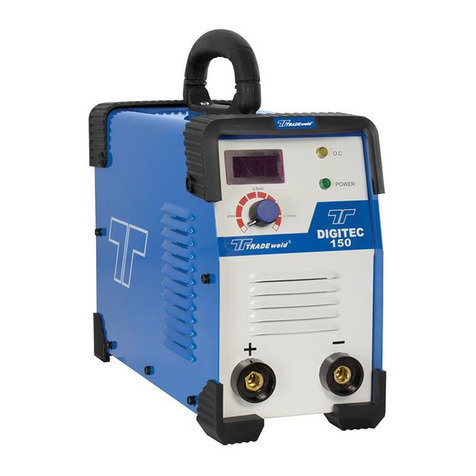TradeWeld GENX MIG2800S INDUSPRO User manual



2
CONTENTS
Contents & Explanation···········································································································2
Safety Warning & Duty Cycle Explained ····················································································3
Machine Description ···············································································································4
Technical Specification ···········································································································5
Accessories & Consumables ···································································································6
Assembly of Bottle Bracket ·····································································································7
Operation of MIG / LIFT TIG / STICK··························································································8-9
Installation of MIG / LIFT TIG / STICK ························································································10-11
Panel Functions······················································································································12
Specification Chart Guide lines ································································································13-14
Typical MIG Process settings ···································································································15
Operating Precautions ············································································································16
Maintenance ···························································································································17
Daily checking ························································································································18
Troubleshooting & Fault Finding ······························································································19
Explosion Diagrams & Part List································································································20
Circuit Diagram·······················································································································21
Warranty & Owners Records ····································································································22
!!DO NOT LIFT THE MACHINE WITH THE BOTTLE ATTACHED!!
Conforms to relevant safety standards.
To reduce the risk of injury, user must read instruction manual.
Do not dispose of old appliances with domestic rubbish.

3
SAFETY WARNING
In the process of welding, there could be possibilities of injury, so please take
protection into consideration during operation. For more details please read the
Operator Safety Guide, which complies with the preventive requirements of the
manufacturer.
Electric shock——Can kill !
⚫Set the earth fitting according to applying standard.
⚫Do not touch the bare electric parts and electrode with uncovered skin, wet gloves or clothes.
⚫Make sure you are insulated from the ground and the work piece.
⚫Think safety first.
Gases and fumes——May be a health hazard!
⚫Keep your head out of the gases and fumes produced by welding.
⚫When welding, ventilators or air extractors should be used to avoid breathing in the gases.
⚫Wear suitable respiratory protection
Arc rays——Harmful to your eyes and will burn your skin.
⚫Wear suitable protective welding mask, light filter and protective garment to protect eyes and body.
⚫Prepare suitable protective mask or curtain to protect bystanders.
Fire——Fire extinguishing equipment kept nearby!
⚫Cutting spark may cause fire, make sure there are no flammable materials or liquids around the working area.
Noise——Excessive noises will be harmful to your hearing.
⚫Use ear protector or others means to protect ear.
⚫Warn bystanders that noise is harmful to hearing.
Malfunction——Use qualified technician to repair machine.
⚫If faulty during installation and operation, please follow this manual instruction on fault finding.
⚫If you fail to fully understand the manual, or fail to solve the problem with the instructions, you should contact the
suppliers or the service centre for professional help.
Gloves——Arc rays will burn your hands.
⚫Wear suitable protective gloves to protect your hands from molten metal.
DUTY CYCLE 60%
Duty Cycle is a percentage of 10 minutes that the unit can weld at rated load without overheating. If unit overheats,
thermostat(s) opens, output stops and the cooling fan runs. Wait fifteen minutes for unit to cool down. Reduce
amperage, or duty cycle before welding again.
Exceeding the duty cycle can damage the machine and void the warranty
CAUTION WORKING LONGER THAN RATED DUTY CYCLE
CAN DAMAGE MACHINE AND VOID WARRANTY

4
MACHINE DESCRIPTION
Thank you for purchasing a TRADEweld product. The TRADEweld MIG2800S INDUSPRO is
manufactured with the most advanced technology in the world.
The principle of this technology is to transform the power frequency of 50Hz/60Hz into
direct current and invert it into high frequency (33 KHz) through high-power IGBT
device’s, then a voltage-drop will be created through the high-power D.C power
transformers with full digital Pulse Width Modulation (PWM) controlled technology. The
development of inverter welding equipment has massive benefits which include greatly
reduced size and weight, greater power efficiency, multi-process capabilities and many
more.
The development of inverter welding equipment has massive benefits which include greatly
reduced size and weight, greater power efficiency, multi-process capabilities and many more. The
inverter welder’s power source produces a much stronger and concentrated stable arc which
results in better quality and more efficient welds.
In MMA mode, this unit is a constant currant DC MMA (Arc) inverter welder.
In Lift TIG mode, this unit is a constant current DC scratch start inverter welder.
In MIG mode, this unit is a constant voltage DC MIG inverter welder.
The MIG Series are very efficient and robust. Using advanced technology together with an array of
adjustment controls you can produce superior MIG welds. The advanced feature of polarity
adjustment allows the welders to use Gas or Gasless MIG wire. The compact size and weight with
it being on wheels and a place to secure the gas bottle to the machine makes it a perfect
candidate for moving the machine around the workshop with the bottle attached.
TIG welding stainless & mild steel with this machine is possible with the scratch start system on the
LIFT TIG function. (TIG accessories not supplied)
A facility has been made for the attachment of a hand held Spool Gun (Not supplied) to be connected
for ease of aluminum welding.
This manual suits for next models
1
Table of contents
Other TradeWeld Welding System manuals
Popular Welding System manuals by other brands

Hobart Welding Products
Hobart Welding Products AirForce 375 owner's manual

GF
GF MSA 330 instruction manual

Hakko Electronics
Hakko Electronics FX-888D instruction manual

Abicor Binzel
Abicor Binzel ABIPLAS WELD 100 W operating instructions

EWM
EWM Taurus 355 Basic TDM operating instructions

Thermal Dynamics
Thermal Dynamics PakMaster 100 XL plus operating manual














